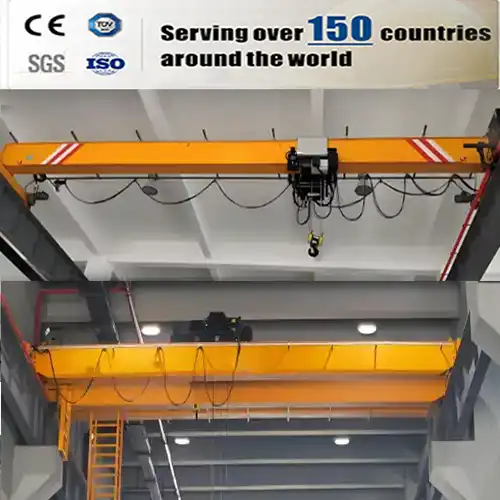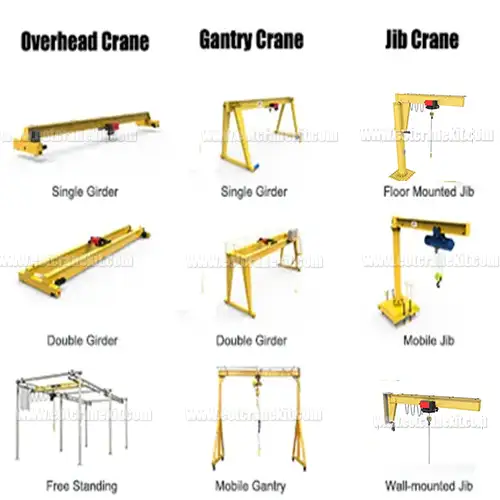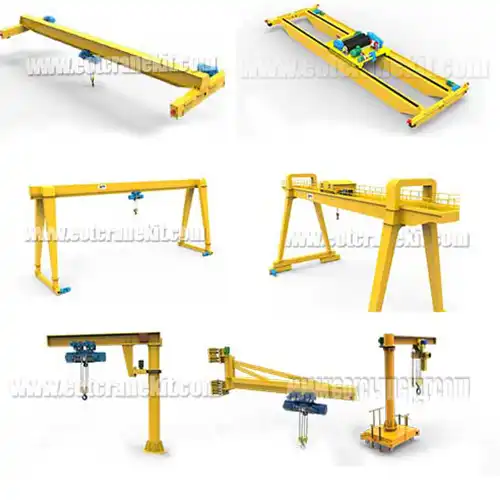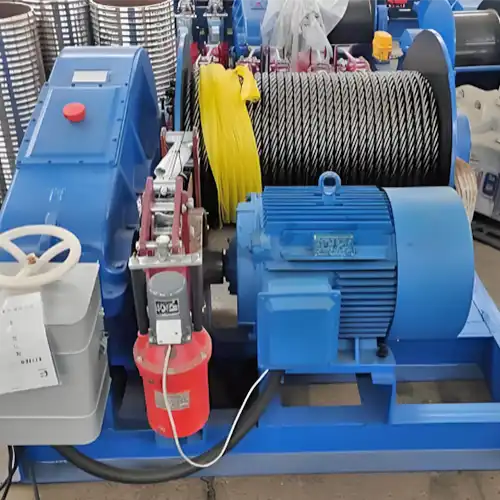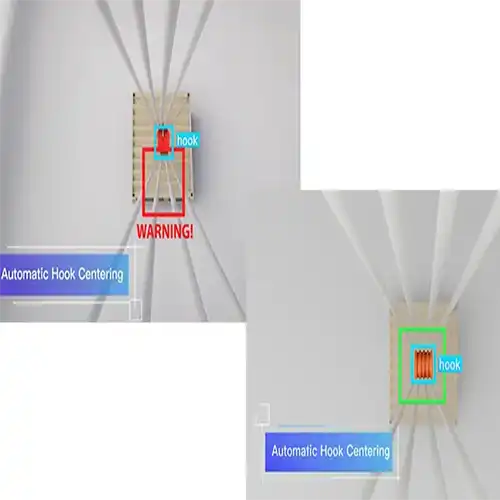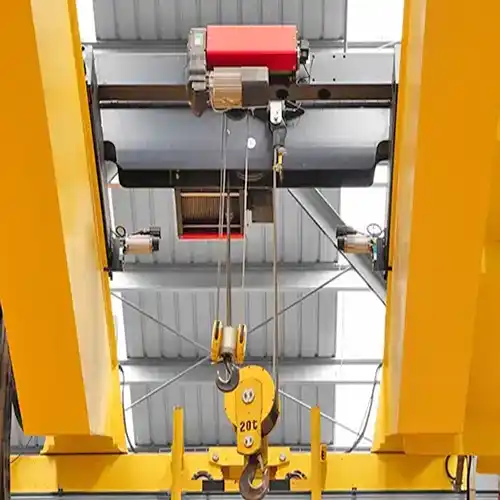Chinese vs. European Standards for Overhead Cranes &Gantry Cranes
A practical comparison of design, welding, electrical& afety standards when sourcing overhead cranes & gantry cranes from China to Europe.Get your crane!
Category: Featured
Your Trusted Overhead Crane & Gantry Crane Manufacturer & Supplier
Chinese vs. European Standards for Overhead Cranes &Gantry Cranes
A practical comparison of design, welding, electrical& afety standards when sourcing overhead cranes & gantry cranes from China to Europe.Get your crane!
Introduction
When you're sourcing overhead cranes or gantry cranes from another country, understanding the different standards is crucial. It's not just about buying a machine; it's about making sure that machine meets local safety, quality, and legal requirements. Without this knowledge, you might end up with a crane that doesn't pass inspection, can't be insured, or worse, isn't safe to operate.
Chinese cranes typically follow their national standards, known as GB (Guobiao). European cranes, on the other hand, must comply with EN standards, along with ISO norms and the CE marking system. These sets of rules cover everything—from how the crane is built, how strong it needs to be, to the electrical safety measures that must be in place.
Knowing the differences between these standards helps you ask the right questions, avoid costly mistakes, and get cranes that fit the working environment and regulations in your region.
Why the difference matters
- Different regions have different safety expectations and technical rules.
- European standards usually have stricter rules around structural fatigue, welding quality, and electrical safety.
- Chinese standards are solid but sometimes more flexible in areas that Europe treats as mandatory.
- Documentation and certification demands are heavier in Europe, requiring full technical files, CE markings, and clear user manuals in English.
Getting a crane right the first time saves time, money, and headaches later on. So, it's worth the effort to understand these basics before you buy.
Structural Design Standards for Overhead and Gantry Cranes
When it comes to the structural design of overhead cranes and gantry cranes, China and Europe use different standards that reflect their own approaches to safety and durability.
In China, the main reference is GB/T 3811, which lays out the basic rules for designing the steel structure of cranes. This standard focuses on the strength needed for the crane's components based on expected loads and general usage patterns.
Europe, however, uses more detailed standards like EN 13001 and EN 15011. These standards not only cover strength but put a big emphasis on fatigue life — how the crane will perform over many cycles of use without developing cracks or weaknesses. For industries where cranes work continuously or under heavy loads, this makes a big difference.
Key differences you should know:
Work classification:
- Chinese standard uses a classification system labeled A1 through A8, which roughly estimates how often and how heavily the crane will be used.
- European standards apply FEM (Fédération Européenne de la Manutention) classes from 1Am to 4m, which are more detailed and account for different load patterns and stress cycles.
Load combinations and safety factors:
- European design codes require detailed calculations for combined loads — for example, when the crane is moving, lifting, and braking all at once.
- Safety factors in EN standards tend to be higher or more carefully applied in critical parts to prevent failure under unusual conditions.
Fatigue and deflection limits:
- EN standards set specific fatigue criteria to ensure the crane's structure lasts longer under repeated use.
- Deflection limits (how much the beam can bend) are tighter in European rules to maintain precision and safety during operations.
| Aspect | Chinese Standard (GB/T 3811) | European Standard (EN 13001, EN 15011) | Notes |
|---|---|---|---|
| Work Classification | A1 to A8 work grades based on general usage cycles | FEM classes from 1Am to 4m covering detailed load cycles | EN FEM classes provide more detailed load spectrum analysis |
| Load Combinations | Basic load combinations considered | Detailed combined loads considered (lifting + braking + motion) | Europe requires more complex load case calculations |
| Safety Factors | Standard safety factors applied | Higher or more carefully assigned safety factors in critical areas | Ensures higher reliability under unusual load conditions |
| Fatigue Design | Limited or general fatigue consideration | Explicit fatigue life and crack propagation analysis required | EN standards aim for longer service life under repeated loads |
| Deflection Limits | Looser deflection limits on beams | Stricter deflection limits to maintain operational precision | Tighter deflection helps in safety and crane control accuracy |
Compared to Chinese GB standards, European EN standards for overhead and gantry crane structural design are generally more detailed and strict, especially regarding fatigue life, safety factors, and deflection limits. This means that a crane designed only to Chinese standards might not automatically meet European requirements without additional checks or reinforcement. For buyers planning to use cranes in Europe, it's important to ensure that suppliers provide design calculations and fatigue analyses based on EN standards. Click to learn more on overhead cranes and gantry cranes for sale China.
Key points to keep in mind:
- European standards use a more detailed classification system that better reflects actual crane usage cycles.
- Load combinations under European rules consider multiple simultaneous forces, making the design more robust.
- Safety factors in EN standards tend to be higher, enhancing reliability under unusual conditions.
- Fatigue life is explicitly analyzed in EN standards, aiming for longer crane service life.
- Deflection limits in Europe are tighter to maintain safety and operational precision.
Make sure to discuss these aspects with your supplier to avoid surprises during engineering review or inspections.
Welding Quality Requirements
Welding quality plays a critical role in the safety and durability of overhead cranes and gantry cranes. The welds hold together the main structural components, so any weakness or defect can lead to serious problems down the line. That's why welding standards differ and why it's important to know what applies where.
Chinese Welding Standards
In China, welding for crane steel structures is governed mainly by GB 50661 and the JB/T 5000 series. These standards set requirements for welding procedures, welder qualifications, and inspection methods.
- Welds must meet certain quality levels based on visual inspection and, when required, non-destructive testing (NDT) like ultrasonic or magnetic particle inspection.
- These standards allow some degree of minor defects, as long as they do not affect the crane's overall integrity.
- Welder qualification follows national norms but generally does not require traceability or third-party certification.
- The focus is on ensuring the weld is sound but may be less rigorous in documentation compared to Europe.
European Welding Standards
European welding requirements for cranes are stricter and more detailed. The two main standards are EN ISO 5817 and EN 1090-2.
- EN ISO 5817 defines weld acceptance levels based on the severity of defects (such as cracks, porosity, and incomplete fusion), with grades B, C, and D representing increasingly lenient criteria.
- For overhead and gantry cranes, critical components like main girders and end beams usually require Grade B or better, meaning very low tolerance for defects.
- EN 1090-2 covers the execution of steel structures and requires factories to implement a certified welding quality management system.
- Welders must be certified according to ISO 9606, ensuring their skills are verified and traceable.
- Non-destructive testing by a third party (such as ultrasonic testing or radiography) is mandatory on critical welds to verify the internal quality.
- Detailed welding procedure specifications (WPS) and welding records must be maintained and available for inspection.
Key Differences to Note
- Welder certification: Europe requires certified and traceable welders (ISO 9606), while China's system is less formalized in this regard.
- Defect tolerance: European standards allow fewer and less severe weld defects, especially for key structural parts.
- Testing and inspection: Third-party NDT inspection is commonly required in Europe but optional or less frequent in China.
- Documentation: European standards demand detailed welding procedure documentation and records, which must be kept for the life of the crane.
Practical Advice
- If you're buying overhead or gantry cranes for European use, insist on weld certificates showing ISO 9606 qualification for welders.
- Ask for third-party NDT reports on the main structural welds, especially on girders and beams.
- Verify the welding acceptance level meets EN ISO 5817 Grade B or better for critical components.
- Check that the manufacturer maintains full welding procedure specifications (WPS) and keeps detailed records.
Ensuring the welding quality meets these European requirements can help you avoid safety issues, failed inspections, and costly repairs after delivery.
Electrical System Standards for Overhead and Gantry Cranes
The electrical system is the brain and nervous system of an overhead crane or gantry crane. It controls lifting, movement, braking, safety systems, and sometimes automation. Poor electrical design or mismatched standards can lead to malfunctions, short circuits, or serious safety hazards.
China and Europe both have solid standards, but they differ in how they approach safety levels, protection, and certification of electrical components. When exporting or importing cranes, these differences need careful attention.
Chinese Electrical Standards
Chinese cranes typically follow GB/T 5226.1 (the general standard for electrical equipment of machinery) and GB 755 (which covers rotating electrical machines).
- Control voltages used are often 110V or 220V AC, and some cranes may still operate with legacy 36V DC systems in control panels.
- Protection level for crane electrical cabinets is usually IP44 to IP54, which gives basic protection against dust and splashing water.
- Emergency stop systems are present but may not always be located or configured to meet international best practices.
- Electrical components like contactors, switches, and circuit breakers are often from domestic Chinese brands—many of which may not hold CE or RCM certification.
European Electrical Standards
Europe relies on EN 60204-1 and IEC 60204-1, which are widely adopted across EU countries and in export markets like Australia and the Middle East.
- Control voltage is strictly limited to ≤50V AC or ≤120V DC for safety, with 24V or 36V AC/DC being the most common for control circuits.
- Electrical enclosures must meet IP55 or IP65 ratings, depending on whether the crane operates indoors, outdoors, or in dusty/wet environments.
- Emergency stop (E-Stop) systems are mandatory and must comply with EN ISO 13850, including red mushroom-head buttons with latching mechanisms located in visible and easily reachable places.
- All electrical components must be CE-certified, and for some regions like Australia, RCM marking is also required.
- Control panels are expected to be labeled in English (or local language), with clear wire numbering, component tags, and grounding marks.
Key Differences to Keep in Mind
| Feature | Chinese Standard (GB) | European Standard (EN/IEC) |
|---|---|---|
| Control Voltage | 110V or 220V AC (sometimes 36V DC) | ≤50V AC / ≤120V DC (common: 24V or 36V AC/DC) |
| IP Rating | Typically IP44 to IP54 | Minimum IP55, often IP65 for outdoor or dusty use |
| Emergency Stop System | Present but may vary in design and placement | Mandatory per EN ISO 13850, must be easily accessible |
| Component Certification | May use uncertified local brands | CE or RCM marking required for all components |
| Panel Labeling | Often in Chinese; labeling may be inconsistent | English or local language, with wire/circuit identification |
Practical Tips When Buying for Europe or Export Use
- Confirm the control voltage with your supplier. If they offer 110V or 220V control circuits, request a redesign to 24V or 36V for compliance.
- Check enclosure protection ratings. For outdoor gantry cranes, IP65 is often required.
- Request CE certification documents for all major electrical components like circuit breakers, push buttons, contactors, and frequency inverters.
- Inspect the layout of the electrical cabinet. Look for clean wiring, wire markers, and grounding terminals clearly identified.
- Make sure emergency stops are correctly installed and positioned per European requirements.
Electrical compliance isn't just a formality—it affects safety, reliability, and the legal approval of your crane installation. Clarifying these requirements early can help avoid major redesigns, import delays, or rework on-site.
Safety and Protection Devices
Safety devices are a critical part of any overhead crane or gantry crane system—not just for protecting the equipment, but for safeguarding workers and nearby operations. While Chinese and European cranes may look similar on the outside, the required safety features can be quite different under each system of standards.
Safety Features in Chinese Cranes
In China, safety devices are typically included based on application needs and buyer preference. The standards suggest what should be used, but enforcement may vary from case to case.
- Overload limiters: Often included for higher-capacity cranes, but may not be standard on lighter-duty models unless specified by the customer.
- End limit switches: Usually installed to prevent the trolley or crane from running off the rails, but their precision and redundancy may vary.
- Emergency stop buttons: Present on most cranes but not always placed for optimal access or designed to international standards.
- Anti-fall devices and safety latches: May or may not be included in standard configuration, especially on manual or semi-automatic cranes.
- Warning alarms and signal lights: Sometimes optional; buyers must often request these as add-ons.
Overall, the inclusion of protection devices in Chinese cranes depends largely on the scope of supply, client requirements, and specific project risks.
Safety Devices Required in European Cranes
Under European regulations, especially those based on EN standards and the Machinery Directive (2006/42/EC), certain safety systems are non-negotiable.
- Overload protection devices: Required to prevent the crane from lifting loads beyond its rated capacity. Must trigger alarms or stop lifting action automatically.
- Travel limit switches: Must be installed for both crane and trolley travel directions to prevent mechanical overrun.
- Emergency stop system: Required by EN ISO 13850. Must be red, clearly labeled, and installed in a location that operators can reach quickly in all modes of operation.
- Phase failure and phase sequence protection: Ensures the crane does not operate with incorrect or unstable electrical input.
- Anti-collision systems: Required when multiple cranes run on the same runway or where the working area includes other mobile equipment.
- Load indicators or limiters: Often digital or electronic, showing real-time weight and providing alerts when nearing capacity.
- Audible and visual alarms: Mandatory for warning during crane operation, lifting, or travel—especially in outdoor or public areas.
These safety systems must be part of the original crane design and verified through CE compliance and documentation.
What You Should Look For (Especially When Buying from China for Export)
- Confirm overload protection is included in the control system and calibrated correctly.
- Make sure travel limit switches are installed for both crane and trolley—preferably with dual-sensor redundancy.
- Check the emergency stop configuration—look for labeled, latch-type buttons within easy reach on the pendant, radio remote, and control panel.
- Request test records showing that all safety devices were tested during factory acceptance.
- Ask for CE certification that includes a functional safety section, not just a structural or electrical checklist.
Buying cranes without the right safety protections might save a bit upfront, but it can cost you more in retrofitting, certification problems, or even accidents later on. Safety is not just about checking boxes—it's about building trust in the equipment you operate every day.
Marking, Documentation, and Certification
Proper labeling and documentation are often overlooked during the buying process—but they are key when it comes to passing inspections, customs clearance, and ensuring safe long-term use of overhead cranes and gantry cranes. These elements also reflect how well a crane manufacturer understands and follows international standards.
What to Expect from Chinese-Made Overhead and Gantry Cranes
Cranes manufactured in China usually meet local documentation requirements under GB standards. However, they often lack the type of marking and files required for export to Europe or other regulated markets.
- Nameplate language: Most nameplates are in Chinese, and only basic data like model, capacity, and voltage may be included.
- Safe Working Load (SWL): This might be labeled, but not always prominently or clearly formatted.
- CE marking: Often missing or incorrectly applied unless the crane was built specifically for European use.
- Documentation: Manuals may be brief, and electrical schematics are often handwritten or missing entirely. English translations are sometimes unclear or incomplete.
- Declaration of Conformity (DoC): Not typically provided unless specially requested.
For domestic use, this level of documentation is often acceptable. For international buyers, especially in the EU, it's not enough.
European Requirements for Marking and Documentation
European overhead and gantry cranes must meet clear, enforceable rules for marking and documentation. These aren't optional—they're part of CE compliance.
Nameplates must be in English (or the local language) and clearly display:
- Manufacturer name and address
- CE mark
- SWL (Safe Working Load)
- Power supply requirements
- Serial number and production date
Declaration of Conformity (DoC) is mandatory and must:
- Refer to applicable EU directives (e.g., Machinery Directive 2006/42/EC)
- List the harmonized EN standards followed
- Be signed by a responsible person at the manufacturer
Technical documentation must include:
- Structural calculation reports
- Welding certificates and NDT records
- Electrical schematics and circuit diagrams
- Operation and maintenance manuals in English
- Spare parts lists and recommended service intervals
These documents are needed not only for project acceptance but also for long-term maintenance and liability protection.
Summary Table: Comparison of Chinese GB vs. European EN Standards
For Overhead Cranes and Gantry Cranes
| Category | Chinese GB Standards (Typical) | European EN/CE Requirements |
|---|---|---|
| Design Classification | GB/T 3811 – A1 to A8 duty class | EN 13001 / EN 15011 – FEM 1Am to 4m, detailed fatigue analysis |
| Welding Quality | GB 50661 / JB/T 5000; basic NDT, local welder certification | EN ISO 5817, EN 1090-2; ISO 9606 welders, third-party NDT |
| Electrical System | GB/T 5226 / GB 755; 110V/220V control, IP44–IP54 | EN 60204-1 / IEC 60204; 24V/36V control, IP55–IP65, CE marked |
| Safety Features | Often optional, buyer-specified | Mandatory: overload limiter, emergency stops, limit switches |
| Documentation | Basic manuals, Chinese nameplate, limited files | CE-marked nameplate, DoC, full tech file, English manuals |
Having the right nameplate, documents, and certificates is more than just paperwork—it's your crane's passport into regulated markets like Europe. Before finalizing any crane order, especially for export, confirm that the supplier understands and can deliver all necessary markings and documentation. It's a small detail that can prevent big problems later. Check European style overhead cranes vs European brand overhead cranes.
Conclusion
When sourcing overhead cranes or gantry cranes from China for installation and use in Europe, paying attention to European standards is not just a formality—it's a basic requirement. Cranes that do not meet EN standards, CE marking, and related technical documentation rules can face serious issues during customs clearance, installation approval, or safety inspection.
Even if a crane performs well in technical terms, it may still be rejected if it lacks proper structural verification, certified weld quality, safe electrical systems, or required documentation like the Declaration of Conformity. These issues can delay your project, increase costs, or force expensive retrofits.
Why European Compliance Matters
- It ensures that the crane can legally operate in the EU or other countries that adopt EN/CE standards.
- It reduces the risk of injury, equipment damage, or insurance rejection due to non-compliance.
- It makes your installation smoother—less back-and-forth with local inspectors and engineering consultants.
- It helps with long-term maintenance and spare part matching, since certified systems follow recognized formats.
Benefits of Working with a Manufacturer Experienced in EN Standards
- They already know the technical file requirements, CE marking process, and duty classifications used in Europe.
- They can provide cranes with IP55/IP65-rated electrical systems, EN-compliant welding, and low-voltage controls (24V/36V).
- Their documentation will typically include English manuals, EN-standard schematics, and signed CE declarations—ready for your site inspection.
- Some can even support third-party inspections (e.g., TÜV, SGS) or deliver cranes with EN 1090 or ISO 3834 welding certifications.
If you're planning to use a Chinese-made crane in Europe, choose a supplier who has already done it before. Ask for project examples, sample documents, and certifications before placing your order. It's the best way to ensure your crane arrives ready to lift—not stuck in red tape.
Related Products
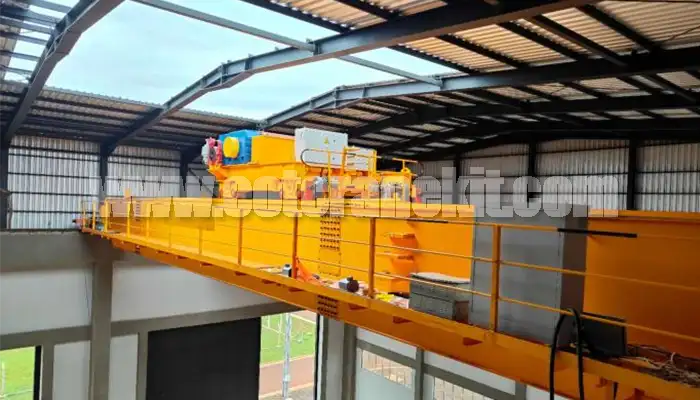
Latest project
150 Ton Overhead Crane Installation Feedback – Paraguay Case
QDX 150 ton overhead crane in action in Paraguay. Installation photos, video, and client feedback show performance, safety, and heavy-lifting efficiency.
Free consultation to Confirm Parameters & Specifications and Get
Latest Crane Price & Crane Rate.
- Types of overhead cranes : _______?
- Optional: Overhead travelling crane, goliath gantry crane,Slewing jib crane, Single girder or double girder crane,small portable crane or kbk crane, etc.
- Capacity of overhead crane: _______?
- Optional: 0.25ton, 0.5 ton, 1 ton, 2 ton, 3ton, 5 ton, 10 ton,15ton, 20ton, 25 ton, 30ton,35ton, up to 550ton, etc.
- Crane span & lifting height : _______?
- Crane travelling length : _____?
- Control of overhead crane:_______?
- Optional: pendant/ remote/cabin control
- Voltage supply of overhead crane:_____?
- Eg,: 380V50/60HZ,3Phase or others,etc.
- Application/usage of crane:_______?
- Eg,: Steel mill, ,injection mold, cement,stone, concrete,granite, general manufacturing, etc.
Just leave a message via the contact form and our hoist and crane engineer will contact you with in 24working hours.
Get In Touch
